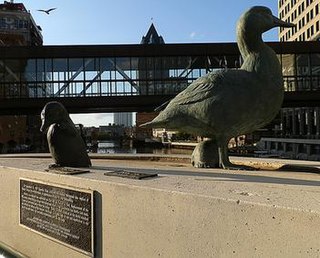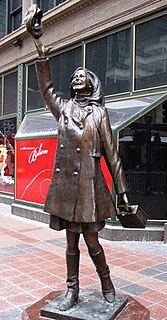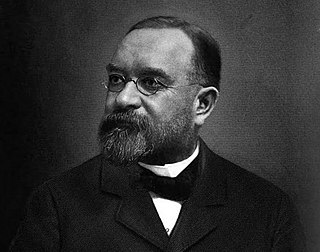
The Avenue is an urban shopping plaza that spans three city blocks in the downtown neighborhood of Westown in Milwaukee, Wisconsin.

The Arcade in downtown Cleveland, Ohio, is a Victorian-era structure of two nine-story buildings, joined by a five-story arcade with a glass skylight spanning over 300 feet, along the four balconies. Erected in 1890, at a cost of $867,000, the Arcade opened on Memorial Day, and is identified as one of the earliest indoor shopping malls in the United States. The Arcade was modified in 1939, remodeling the Euclid Avenue entrance and adding some structural support. It was designated a National Historic Landmark in 1975.
Hundreds of replicas of the Statue of Liberty have been created worldwide.

James Ludington was an American entrepreneur, businessman, lumber baron, and real estate developer. As a businessman he would loan money to other businessmen. In one such loan he had to foreclose for delinquent payments on a sawmill operation in Michigan. He ultimately obtained the sawmill in the village of Pere Marquette. Ludington platted the land there and formed a town with a lumber company operation. He later sold his interest to the lumber company for a large sum of money and became very wealthy. The town later changed its name and became Ludington, Michigan, although he never lived there.

John S. Conway, an artist and sculptor, was born February 21, 1852 in Dayton, Ohio. His middle name is listed differently in different sources as Severinus, Severine and Severino. He received his artistic training at the Art Institute of Chicago, the Ecole Julien, and at the École des Beaux-Arts. Conway also lived in Milwaukee, Italy, and New Jersey. While Conway was in Paris, Robert William Vonnoh, a fellow art student, painted his portrait.

Gertie the Duck is an icon of Milwaukee, Wisconsin history and the subject of a 4-foot tall bronze sculpture by American artist Gwendolyn Gillen. It was installed on the Wisconsin Avenue bridge in September 1997.

Albert C. Nash was an architect in Cincinnati, Ohio and Milwaukee, Wisconsin. He was a founding member of the Cincinnati chapter of the American Institute of Architects and served twice as the group's president, from 1873 to 1877 and 1882 to 1885. The Milwaukee Court House that was constructed in 1872 and demolished 1939, as well as St. Stanislaus Church in Milwaukee.

The Chase Tower is a 22-story, 288-foot-tall (88 m) high-rise building in downtown Milwaukee, Wisconsin. Built in the International style, the building has a very dark green, almost black, facade. It is located alongside the Milwaukee River, at the corner of East Wisconsin Avenue and North Water Street. The Chase Tower includes 480,000 square feet of office space and a 746-space parking structure.
Henry Bergh is a statue by American artist James H. Mahoney located at the Wisconsin Humane Society in Milwaukee, Wisconsin, United States. The bronze statue portrays Henry Bergh, the father of the humane movement in the United States, holding a cane in his proper right hand and petting a dog with a bandaged paw with his proper left hand. It was created in 1891 and stands 9 feet high.

Spirit of Commerce is a public artwork by German artist Gustav Haug located in Jackson Park, which is on the south side of Milwaukee, Wisconsin, United States. This zinc sculpture is 15 feet tall and sits on a red granite pedestal near the park's lagoon. It is the oldest public sculpture in Milwaukee.

The Washington Monument is a public artwork by American artist Richard Henry Park located on the Court of Honor in front of the Milwaukee Public Library Central Library, which is near Marquette University in Milwaukee, Wisconsin. The bronze sculpture is a full-length portrait of a 43-year-old George Washington, and stands on a granite pedestal; a bronze woman points up at Washington while a child, also made out of bronze, gazes upward. It was sculpted by Richard Henry Park and was erected in 1885 with philanthropic financial support from Elizabeth Plankinton. The statue was restored 2016-2018.

General Douglas MacArthur is a public artwork by American artist Robert L. Dean, a 1953 graduate of the United States Military Academy. Previously, the statue was located in MacArthur Square in the Milwaukee Civic Center Plaza, downtown Milwaukee, Wisconsin, USA. On June 7, 2014, it was relocated to its new waterfront location at Veterans' Park, next to the Milwaukee County War Memorial Center. With full military honors, the bronze statue of General Douglas MacArthur was rededicated at its new home on June 7, 2014. The ceremony was the capstone event for the MacArthur Memorial Week, held nearly 35 years after the statue's original dedication on June 8, 1979.
Sculptor Aloys Loeher (1850–1904) was an American sculptor. He created a signature piece which was exhibited at the 1893 Columbian Exposition. Among his other works are the Siegfried Monument in New York, the Fritz Reuter Monument in Chicago, and a number of medals and busts.

The Elizabeth Plankinton House was a stone structure in Milwaukee, Wisconsin, intended to be the residence for Elizabeth Plankinton. Built between 1886 and 1888 by John Plankinton for his daughter as a wedding gift, it cost at least $100,000. Architect Edward Townsend Mix designed the house in the Richardsonian Romanesque style. It was located opposite John Plankinton's own house on Grand Avenue in an upscale residential area of the western part of the city, near other mansions. Mrs. Margaret Johnston was the only person to have a permanent residence in the house (1896–1904). The Knights of Columbus used the property between 1910 and 1978. Despite being listed in the National Register of Historic Places in 1976, the house was demolished on October 11, 1980, to make way for student facilities for Marquette University.

The William Plankinton Mansion was built in 1876 by the millionaire meatpacking entrepeneur John Plankinton and presented as a wedding gift when his son William Plankinton married Mary Ella Woods. Located at 1529 W. Wisconsin Avenue in Milwaukee, Wisconsin, the Victorian style residence was designed by E. Townsend Mix, the most prominent Milwaukee architect of that era. One of its notable ornaments was a lion's head on its external marble-faced construction. The interior featured ornate woodwork, and the stairwell was illuminated by a stained glass window. The building was sold in 1918 to Marquette University and for decades served as a hospital annex. In 1969 it was demolished to make way for new university structures.

Gwendolyn "Gwen" Gillen was an American sculptor and artist. Her best known works include a bronze sculpture of actress Mary Tyler Moore tossing her Tam o' shanter hat into the air as a homage to the final scene of opening credits of The Mary Tyler Moore Show. Gillen life-size sculpture of Moore, which dedicated in 2002 in the Nicollet Mall in downtown Minneapolis, has own of the city's most recognizable landmarks and "symbol of Minneapolis". Her other well known pieces include a 4-foot bronze sculpture of Gertie the Duck, which was installed on the Wisconsin Avenue bridge in Milwaukee in 1997.





























